What’s the difference between Speedlights and Studio Strobes?
When considering setting up a home studio for photography, whether it be for portrait, product, or food photography, the most important decision is typically regarding the lighting. Should you go for continuous lighting or strobes? And if going for strobes, should you go for speedlight flashguns or studio strobes?
I've covered the differences between continuous lighting and flash in the article LED Light panel vs. Flash. So in today's article I want to look at the choice between speedlight flashguns and studio strobes. We'll look at the benefits and disadvantages of each system, to help you make the decision as to which will work best for your purposes.
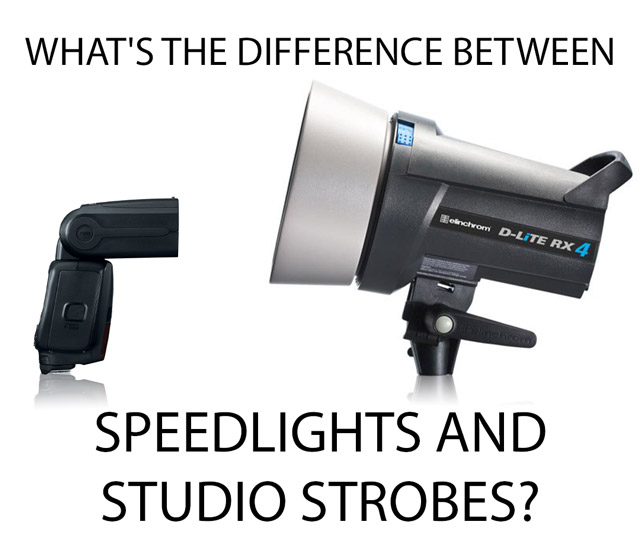
Canon 600EX-RT Speedlite Flash and Elinchrom D-Lite RX 4 Studio Strobe
Portability
One of the most obvious differences between speedlight flashes and studio strobes is how portable they are. Studio strobes are larger and heavier than speedlight flashes. Most camera bags will easily allow you to carry a couple of speedlight flashes with your other gear when going on a location shoot. But fit a couple of studio strobes in a bag (if you can), and there won't be much room for anything else.
And that's not to mention the power requirements. Studio strobes require either AC power or power from a large and heavy (and expensive) battery pack. So if you want to use your strobes outside of the studio, then you'd better be sure that there'll be a power outlet, or not mind lugging a big battery pack around. (And not all studio strobes have battery packs available - some are confined to mains power only).
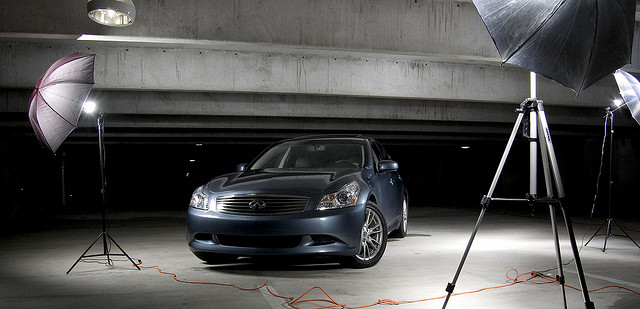
Giorgio. by Rick Flores on Flickr (licensed CC-BY)
While speedlight flashes are a lot more portable than studio strobes, whether this is actually a benefit depends on the photography you do. If you like shooting outside, and in locations that are some distance from any parking, then the low size and weight of speedlight flashes will be a definite advantage. But if you mainly shoot in the studio, or in locations where power is available, or locations where you can just take everything in the car, get it out, and start shooting, then the weight and size of the strobes is not so problematic.
A related issue is how you can position the lights. With studio strobes, you'll need something relatively strong to hold them up, typically a light stand. Speedlight flashes, on the other hand, can be attached to a nearby post or beam using a bungee cord or superclamp. This does depend on the suitability of nearby items for attaching the flash to. But in some cases this can allow you to put a light somewhere that you just wouldn't be able to fit a studio strobe.
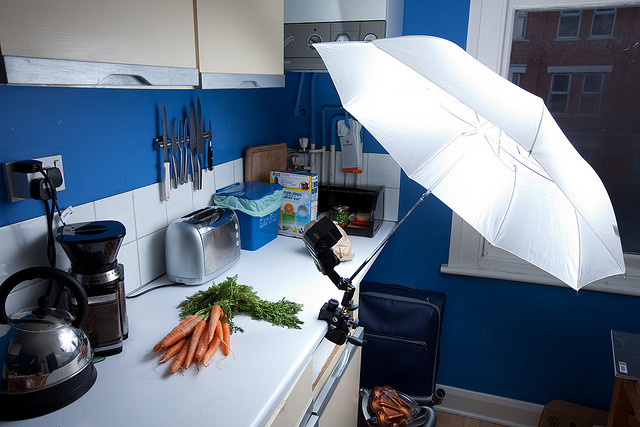
Carrots lighting setup by Matt Biddulph on Flickr (licensed CC-BY-SA)
You certainly can't add a studio strobe to your camera's hot shoe anyway, that's for sure!
While neither speedlights nor studio strobes are designed to work in wet or dusty conditions, I'd much rather be using a speedlight in these conditions. Although they are not weather sealed, they can usually stand a little bit of rain. There is no large battery or AC power to worry about getting wet, though the capacitor in a speedlight can still hold a large charge, so it's not completely safe either.
Light power
Studio strobes are typically much more powerful than speedlight flashes. This means you can position the light further away from the subject and have it fire through more layers of diffusion (for softer lighting) without having to worry about the maximum light output not being bright enough.
Another benefit is when you want to use feathered lighting - this is extremely soft lighting where you hit your subject with just the edge of the (already diffused) light. A speedlight flash may not have enough power to allow you to do this while still having the subject well lit.
If you are photographing outdoors during the daytime, a studio strobe can also allow you to overpower the sun. This produces a shot with a very dark sky, where the sun acts as a second light source, rather the primary one. A single speedlight flash has to be extremely close to the subject to create a similar effect.

Porshe 911 GT3 by Jinggo Montenejo on Flickr (licensed CC-BY)
You can achieve more power with speedlight flashes by doubling or even quadrupling them together. 2 flashes gives 1 stop more maximum power than a single flash, while 4 flashes gives 2 stops more (each stop is a doubling of power). You can even buy special brackets for holding multiple speedlights together like this to create a more powerful light.
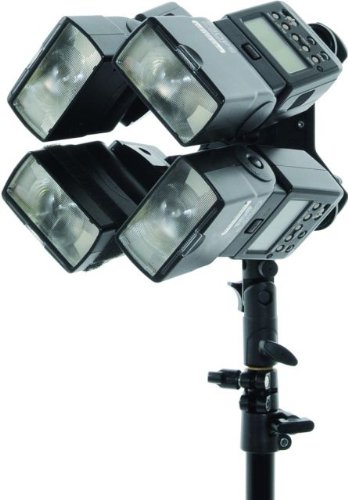
Lastolite LL LS2535 Speed Light Quad Bracket
But if you're using 2 or 4 speedlights in place of a single strobe, then you're loosing the size and weight advantage. You have to buy special brackets to hold them in place. And they won't work with any lighting modifiers you have that are only designed for use with a single speedlight. Plus you can have trouble with the batteries running out on one flash before the other.
So if you need a lot of power in your lighting, then you are best off going with studio strobes. If you only need high power flash occasionally, then you may be able to get away with using speedlights. For the majority of work though, the power of a speedlight is fine, and the extra power of a studio strobe is not needed - you'd typically be using it quite a bit under full power.
Recycle time
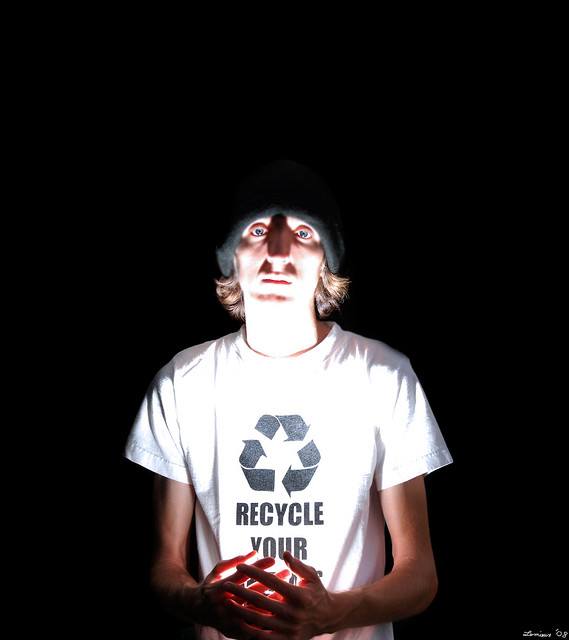
Recycle Your Animals by John Lemieux on Flickr (licensed CC-BY)
A related issue to light power is the recycle time. This is the time it takes for the flash to recharge from firing to being ready to fire again. Since studio strobes are typically used with mains power, they recycle very quickly. Speedlight flashes, with their AA battery power sources, on the other hand, have much slower recycle times.
Whether this is an issue depends on both how much power you need from your lights, and how quickly you move from taking one photo to another. Speedlight flashes used at low power have quite a fast recycle time, but as you boost the power, the recycle time increases.
If you're photographing portraits in a studio, then a fast recycle time can be quite useful, you can take a photo and then take another one quickly as the subject changes their expression or pose. The issue of power source also comes into play. You don't want the batteries on your flash to die just as your subject is getting used to be photographed and starting to give you more natural poses.
For work like product or food photography though, then recycle time is unimportant. There is no urgency and you can afford to wait between shots while your flashes recharge.
Flash duration
Another point that is linked into the flash power is the flash duration. Studio strobes can typically put out more light in a shorter period of time than a speedlight flash can. For the vast majority of uses, the flash duration is unimportant - it will typically be around 1/250s or faster, which will freeze most motion when combined with a similar shutter speed.
However, for high speed photography work, such as photographing splashes or items smashing, then a short flash duration becomes more important. The flash duration becomes the effective shutter speed, so a short duration helps you capture sharp images of subjects in fast motion.
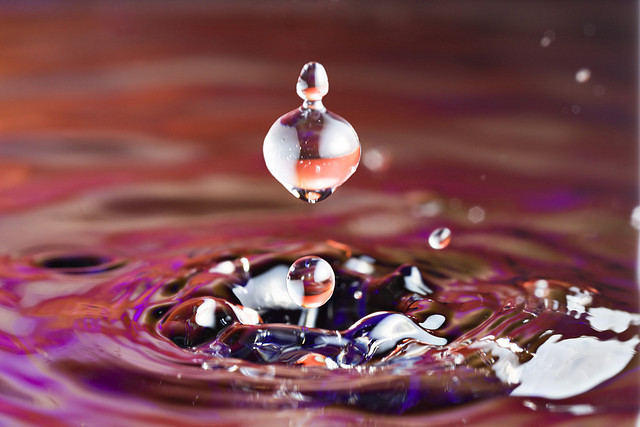
Drip by Andrew Magill on Flickr (licensed CC-BY) - speedlight flash at low power and very close to subject used for fast flash duration.
Speedlight flashes actually have very short flash durations when used at low power settings. However, at higher power settings the duration is much longer. Studio strobes can be quite variable in their flash durations, but there are quite a few models that can put out a good amount of power at a much faster flash duration than a speedlight flash could manage for the same amount of light. You can see the results of a test between a variety of speedlight flashes and studio strobes here: Actual Measured Flash Durations of Small Speedlight Strobes.
So if a short flash duration combined with a reasonable amount of power are important to you, then studio strobes are probably the way to go. Make sure you check the flash durations for any units you are interested in though, as not all strobes feature fast flash durations.
Color Temperature
If you're doing product photography and need accurate color in your images, then the color temperature accuracy of your lights is important. Speedlight flashes and some cheaper studio strobes do not feature a constant color temperature. As you increase or decrease the power of the light, the color temperature may change. This typically won't be a massive shift, but where color accuracy is important, it may be enough to cause a problem.
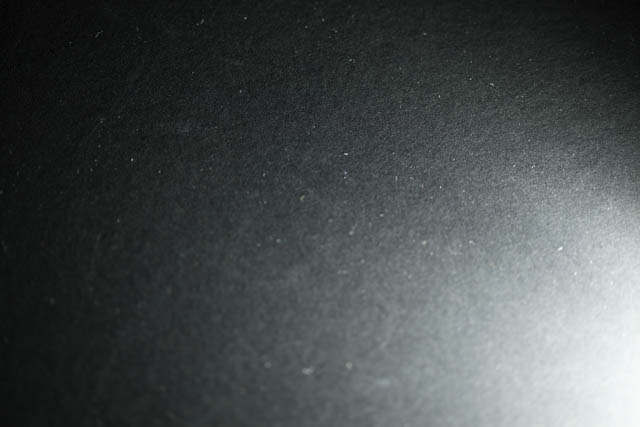
Speedlight fired at minimum power (1/128)
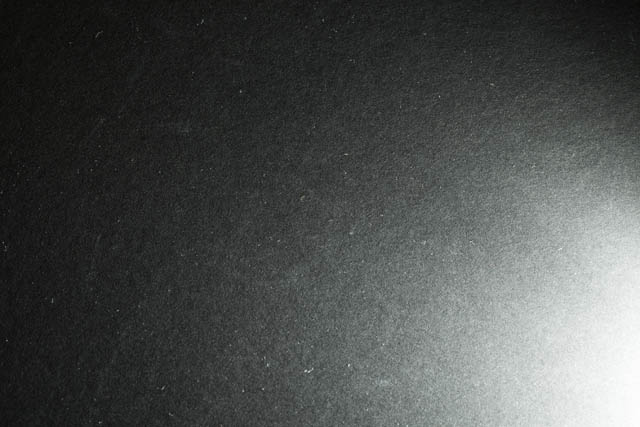
Speedlight fired at full power, the color temperature is slightly warmer
This problem will manifest itself if you are photographing a subject with multiple lights set at different powers. If you have one light at a high power e.g. 1/2 and another at a lower power e.g. 1/32, then there will be a color temperature difference between the two lights. Where exact color accuracy is not needed (i.e. most photography), then this is not an issue. But it is something worth being aware of.
Accessories and modifiers
There are a wide range of accessories and light modifiers available for both studio strobes and speedlight flashes. My advice here would be to consider the accessories and light modifiers you want, and then compare the costs. In some cases accessories for strobes are cheaper, in other cases the speedlight accessories are cheaper.
For example, stripboxes (particularly useful in product photography) are quite difficult to find in designs intended to work with speedlights, and more expensive than the equivalent versions designed for strobes. On the other hand, colored gels are much cheaper for speedlight flashes as they don't need to be as large. They're much easier to attach to speedlights too, no filter holder is needed.
One thing to note is that when using a light with a light modifier designed to diffuse the light, such as a softbox, then a studio strobe may give slightly better, more even lighting. This is due to the way many strobes are designed, with a larger ring type flash tube at the front of the flash, rather than a small straight flash tube stuck inside a permanently attached reflector, as it is with a speedlight flash.
This means that the light will spread out more evenly to the sides with a studio strobe, rather than just being pushed straight forward as a speedlight does. In a softbox this means the light gets bounced around inside the box more, which in theory gives more even illumination. This difference is usually pretty minimal in practice though.
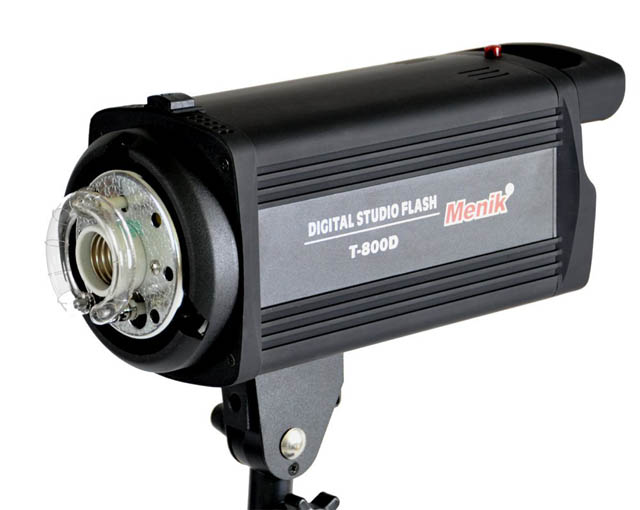
CowboyStudio T800D Monolight strobe Flash - you can see the circular bare flash tube at the front of the strobe when no reflector dish is attached.
Triggering
There isn't much of a difference between studio strobes and speedlights when it comes to triggering. Both have some models available with built-in triggering systems (optical or radio or both). And both have models available without anything built in, but a jack that you can attach an external optical or radio trigger to.
I just thought I'd mention it, as whether a flash includes triggering built-in, and if it does, the type of trigger it includes, is a point you should consider when looking to purchase a strobe or speedlight.
Modeling light
A big difference between studio strobes and speedlight flashes is that strobes typically (though not always) feature a modeling light. This is a constant light that allows you see how the light from the flash will fall without having to take a test shot. The modeling light switches off when you take a photo, so you don't need to worry about the modeling light adding any extra light to the scene.
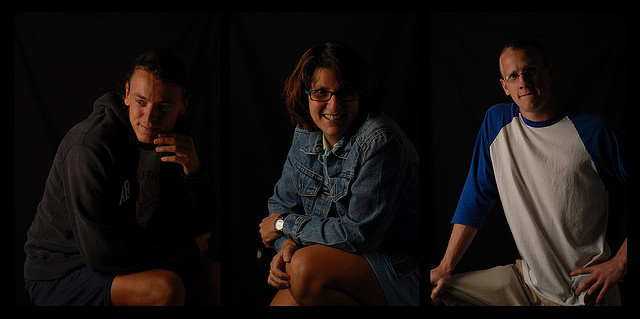
studio playtime by Beth Rankin on Flickr (licensed CC-BY) - shot using only the modeling light
For the majority of photographers, a modeling light would probably be best described as 'somewhat advantageous'. Yes, it does give you a preview of the lighting. But you'll likely still need to take some test shots and adjust the light position and power to get the lighting just right. And with experience you can usually make a rough guess of how the light will fall on your subject anyway without a modeling light.
Auto flash exposure
Camera manufacturer branded speedlights (and quite a few third party models) can 'talk' to the camera and each other (when you're using more than one flash) to automatically determine the optimum power output to use for a correctly exposed image. There are very few studio strobes that can do this, and those that can (e.g. the ProFoto B1 AirTTL ) are very expensive.
The main benefit of having the flash automatically set its power is when you are working in changing conditions. For example, if you're shooting an outdoor portrait at sunset and combining flash with the ambient light, then the flash can adjust its power as the natural light level reduces. If you change your exposure settings on the camera, then the flash will adjust its power appropriately to compensate.
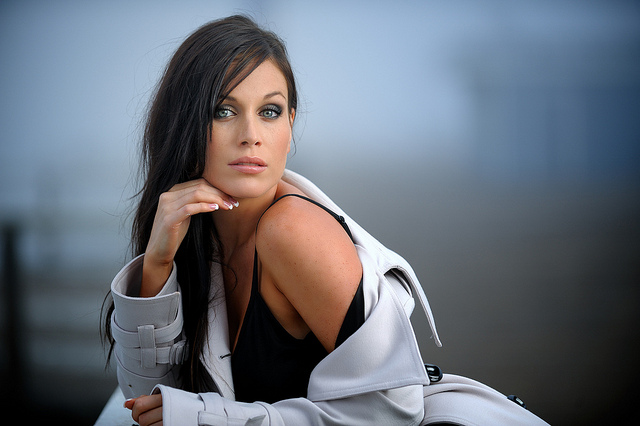
Fog by Alan Antiporda on Flickr (licensed CC-BY) - lit using an off-camera speedlight in TTL mode
For photographers that move themselves and their light(s) around a lot, such as an event photographer, then TTL flash can definitely be useful. But if you're the type of photographer that is considering studio strobes, then it's likely that you won't be shooting in situations where the flash power needs to constantly be modified.
TTL flash can be nice to have, but you'll generally want to adjust the flash exposure compensation for each flash to get the lighting looking how you'll want it. So it doesn't really save much time compared to manually setting the flashes to the power you need.
Power control
The level of control you have over the power output of the light varies widely for both studio strobes and speedlight flashes. In general, speedlight flashes offer a larger range of control and more refined control than studio strobes. For example, a speedlight may offer full power down to 1/128 power in steps of 1/3 stop, whereas a studio strobe may offer full power to 1/16 power in steps of 1 stop.
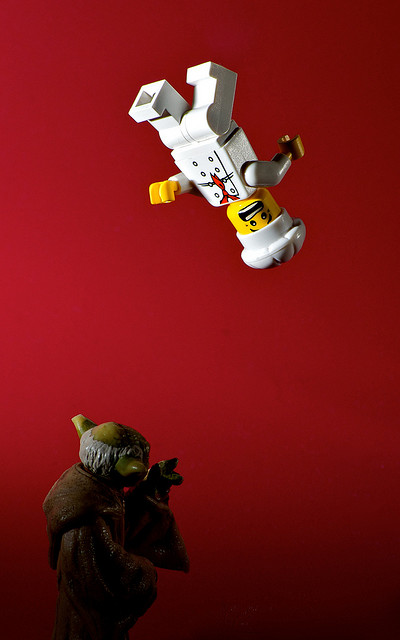
When Yoda Gets Hungry.... by Kevin Thai on Flickr (licensed CC-BY-ND) - lit with speedlight flashes at 1/64 and 1/128 power
That a speedlight gives more control is most definitely a generalization though - there are studio strobes with a large amount of control over power, and speedlight flashes with no control over power. You should check the specifications of any flash or strobe you are considering to check how much control it gives you. Bear in mind that if a studio strobe only goes down to 1/16 power, this will be equivalent to around 1/8 or 1/4 power on a speedlight in terms of actual light output, due to the strobe being that much more powerful.
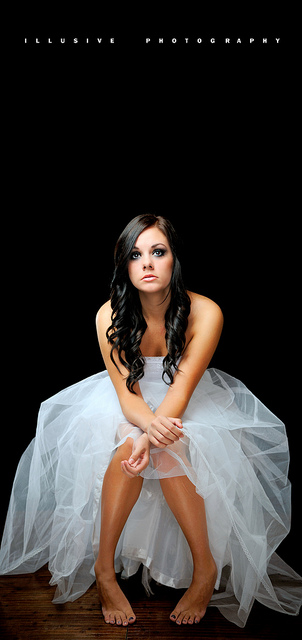
Petticoat by Alan Antiporda on Flickr (licensed CC-BY) - shot with studio strobes at 1/64 and 1/32 power
While more control is always going to be better, it isn't essential. If a strobe only offers adjustments in full stops, you may occasionally find that one setting is too dark, while adding a full stop of power is too bright. In this case you can either adjust the ISO or aperture on the camera, move the light a little further from your subject or add some light diffusion in front of the strobe.
Similarly, if you have a strobe at minimum power but it's still too bright, and you don't want to adjust the camera settings, then you can add some diffusion or a neutral density gel to the light to reduce its power.
Cost
Most photographers seem to be under the impression that studio strobes are much more expensive than speedlight flashes. It's true that the top models from brands like Profoto and Broncolor can be very expensive. But actually the price between a high end speedlight and decent studio strobe is pretty similar.
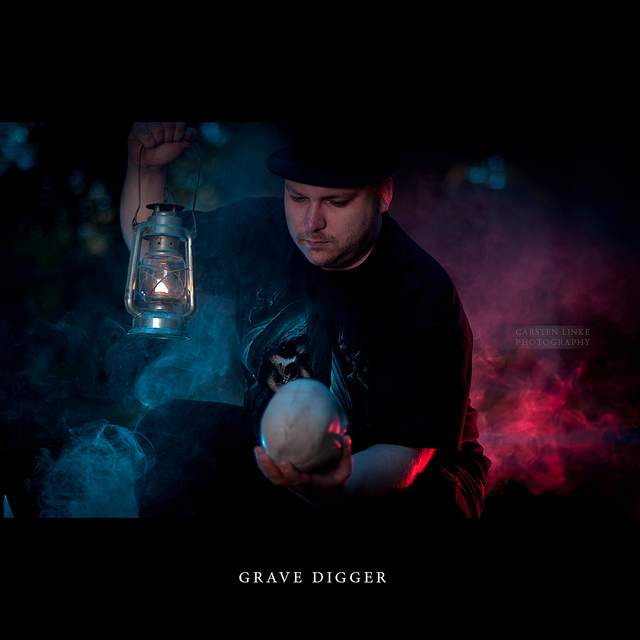
grave digger by Carsten Linke on Flickr (licensed CC-BY) - lit using speedlight flashguns
When you start looking at the cheaper end of the market though, I think most people would argue that speedlights offer the better value. Flashes such as YongNuo's 560 series offer many of the features of the top end flashes, but at a much lower price. Whereas studio strobes in the same price bracket are typically lacking in power and features compared to the higher priced models.
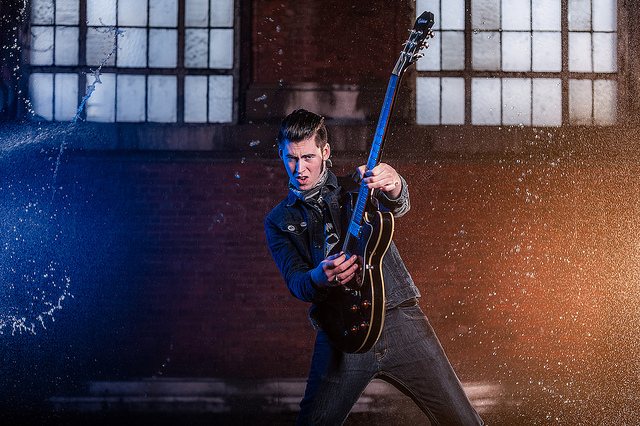
The Tram Tours by Jonathan Vahsen on Flickr (licensed CC-BY-ND) - lit using studio strobes
The cost of studio strobes can also vary quite a bit depending on your location. For example, Paul C. Buff strobes are a popular choice in the US for their respectable combination of power, features, and low cost. But in Europe these strobes are much more expensive. Speedlight flashes, meanwhile, are sold for around the same cost everywhere. (Obviously there will be some difference, especially when factoring local taxes into account).
Hopefully this article has helped you think about what it is you really need in a lighting solution, and so decide which is best for you. Both speedlights and studio strobes can produce nice lighting, but they each do some things better than the other. It's just about figuring out which features are most important for the photography that you do.
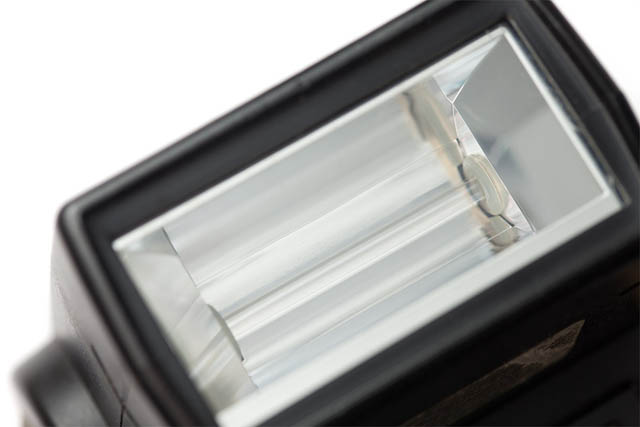





One of the best reads about this subject. Loved the way you have touched upon the differences and pros n cons with a balanced approach.
it answer all.my questions ….thank you